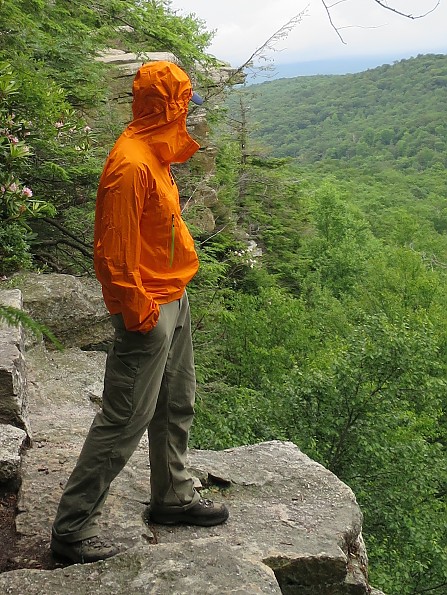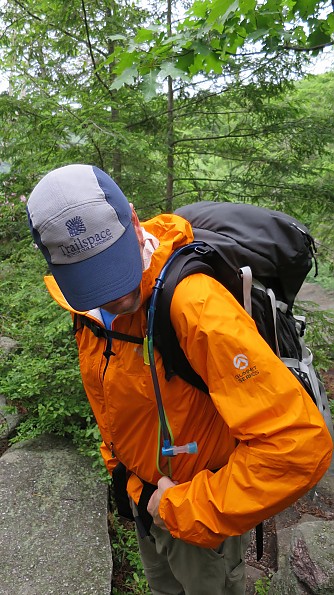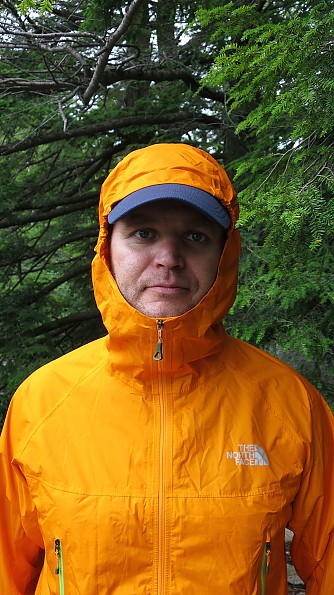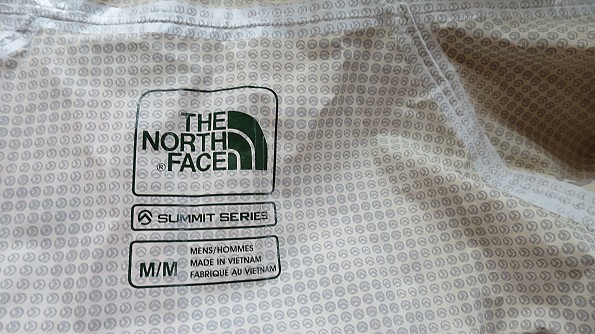The North Face Verto Storm Jacket
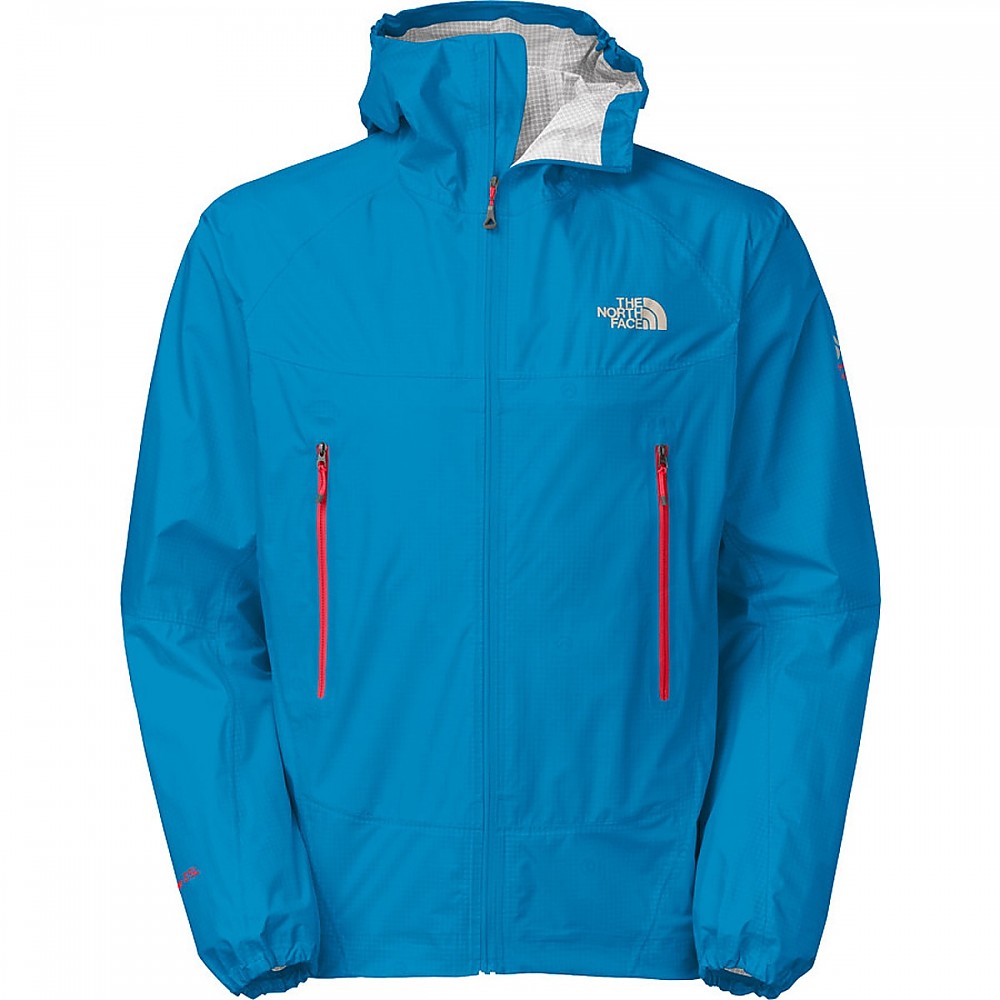
Silent Orange Is The New Black! This is a high quality waterproof, breathable storm jacket that is very useful for (dare I say) fast and light summit approaches, climbing, hiking, or any outdoor activity where weight is a significant factor.
Pros
- Lightweight
- Compact for stowing
- Great high visibility color
- Comfortable cut/fits well for climbing and backpacking
Cons
- Not very breathable
- Price
- Overall durability is questionable
- Inner material surface ‘tacky’, difficult to pull sleeves on/off
- Zippers Feel Weak
- No Adjustments For Hood, Waistline, and Wrist-Cuffs
- Difficult To Zip Up Mostly To Neck While Trying To Keep Rain Out
This rain jacket appears to be focused toward the athlete and minimalist, rather than the mainstream market that some of the larger companies like TNF and Eddie Bauer typically place their attention. The product group line is called the ‘Summit Series.’
The North Face Hyvent is listed as a ‘waterproof, breathable technology utilizing a polyurethane (PU) coating that consists of a tri-component, multi-layer formula for waterproof protection, moisture permeability and durability.’ Based upon TNF’s description of the product, it appears to correspond with what I have found.
Testing Conditions:
I have worn this jacket around town, on multiple hiking trips and backpacking trips in the Appalachian mountains of Western Maryland, West Virginia, the Hudson Valley Highlands/Shawangunk mountains in upstate New York, and the Green Mountains in Vermont.
I also have worn this jacket at times on a quick summit to Mt. Mansfield, Vermont, and Maryland Heights overlooking Harpers Ferry, W.V. Unfortunately, a hand injury (and work schedule) has not cooperated for any climbing with this jacket. All use has been during the spring/summer of 2014. I have worn this jacket with 10-15 lb. on day hikes, and 35+lb. backpacking trips.
Shawangunk Mountains, N.Y.
The North Face Summit Series logo on the arm of the jacket.
Size Tested:
- Men’s M (I’m 5’10” 160lbs, 40” chest/32” waist19” torso)
Other Pertinent Details:
- MSRP: $199
- Windproof/Waterproof/Breathable
- 15 Denier 61g/m2 HyVent 2.5 Layer 100% nylon ripstopWeight listed as 200g (7.05oz) average. My scale: 7.0 oz/200g
- Harness/Backpack compatible front pockets
- Built-in internal stuff sack (sewn into right pocket)
Light rain at VerKeerderkill Falls in the Gunks, N.Y.
FIT:
This jacket fits well for a lean build; this is a pretty athletic cut. The chest area is quite trim; I would recommend selecting a size larger for people with broad shoulders/larger chests. One could argue the arms are on the long side, however this is pretty similar to most apparel cuts in the industry. The sleeves provide ample coverage when reaching, even when wearing a backpack or daypack.
This jacket would be difficult to layer with. There is so little extra space that one’s base layer and middle layer would end up making the shell skin-tight! A mid to heavy weight base layer (Icebreaker 260) under the jacket does provide a comfortable system however.
Intense physical activities like summit climbs or trail running require so little insulation during the activity, but the challenge is staying warm on the way back down! With so little underneath the jacket, a cold downpour can easily bring hypothermic conditions.
This jacket is stylish enough to wear around town!
The neck area of the jacket always lays wide-open when mostly zipped.
The waistline of the jacket is pretty trim.
The wrist cuffs stay put when making a reach, and the drop hem still provides ample coverage.
An example of the jacket’s arm length without a pack.
The arm length feels right when wearing a backpack.
The hood has a tight fit when wearing a helmet (sorry, no photo). It is also somewhat difficult to adjust/keep in place when not wearing a helmet or baseball style hat. I have been spoiled by wire brims in a rain jacket, which is not going to be found in this style of jacket.
There is not a whole lot of room to spare in the hood, even with a TS hat on.
Red Creek Trail, Dolly Sods Wilderness, W.V.
I have found the pockets to be sufficiently accessible when wearing a pack, however they are designed for flat items, like an ID card or an energy bar. Although there is a clear benefit with having these pockets, I think many people would agree that the extra layer of material greatly reduces the ventilation/breathability in the torso area. The drop-hem in the waistline does a good job of protecting the lower back from rain and wind, even when one’s arms are working.
The pockets are positioned well for use with a harness or pack.
One of my biggest gripes about this jacket is the waxy inner material. I have often felt like I am in a fight with my own body getting my arms in and out (to the point I’m afraid i will tear a seam)! I don’t know how common this material is with other jackets out there, but finding this shopping in a store would make the Verto Storm Jacket a DEAL BREAKER.
Inner jacket material showing a few of the taped seams.
Here is a close-up photo of the inner material; when dry it looks and feels very paper-like.
This jacket is so light and compressible, it easily stuffs into a daypack. Like many stuff sacks, I find it difficult to fit into its built-in bag which is sewn into the top of the right pocket. The stuff sack does not properly close, with a simple fold-over closure and elastic band.
In my opinion, this is another piece of unnecessary material, and cuts overall breathability. I find just folding the jacket or stuffing it on top of my daypack’s other contents works best; it still compresses just as easily, and is quicker to get on when that sudden downpour hits.
Front view of the built-in stuff sack.
The stuff sack closure bursting.
Perspective of the stuff sack next to a couple of 32oz. Nalgene bottles.
Water Resistance/Breathability:
Since the Verto Storm Jacket was designed to be as light as possible, it comes with the expected sacrifices. Other than the primary main zipper, there are no other adjustments offered on this model. I personally feel the lack of armpit ventilation is not a minus at all, I have always been able to get adequate chest ventilation by using the main zip.
The waistline, like the hood has no adjustability beyond the sewn-in elastic, which can possibly be considered a downside. The cuffs can give a restricted feeling if they are slid up the forearm. All of these fits seemed fine to me, except for the neck area. If one were to zip up but not all of the way, the neck area always opens forward, like a spout. This is clearly not ideal when wearing a storm jacket!
The fully taped seams of the Verto Storm jacket has shown to be a truly waterproof jacket, which accomplishes its primary goal. In no way has rain made its way through the jacket. I did not find any water infiltration, so I can’t find a concern with this. In the past, I have always used cheap ponchos for their good ventilation, or a heavy-duty shell for cold weather hiking and adventuring. I can’t imagine this category of clothing to have a substantial lifespan…
As for the breathability, it appears to leave me wondering. I find the breathability to be okay when under little load, however condensation/sweat really builds up when backpacking. After lowering my arms when holding trekking poles, water just pours out from the wrist cuffs! This is a very subjective finding, since everyone layers and sweats so differently. I have personally found it to do a less than satisfactory job when wearing a single synthetic base layer (like the Rab Aeon), or no shirt in high-load conditions.
After taking a short break, turning the jacket inside-out, shaking it, and putting it back on, the jacket seems to shed most moisture. The most wind I encountered while wearing this jacket was probably around 30mph. As a wind-breaker, the Verto performs admirably.
Light rain beading on the jacket as designed.
Construction/Durability:
I have long-term concerns with the overall durability of this jacket, however it has held up over the course of the last several months. It appears to be well constructed, but a 15 denier nylon is only going to get you so far. My construction concern is the zippers used throughout. TNF uses a very (VERY) fine-toothed zipper, which I cannot see lasting very long. There is so little material at the bottom of the main zipper that I always feel like it is going to tear.
The small zipper ‘garages’ for the pockets are also so small and flat that it would take minutes to seat them the way they are designed. The materials used seem to be of high quality. The PU coating has not degraded after three washings. The interior taped seams are still in perfect condition.
Main zipper.
Front pocket.
Conclusion:
My overall opinion of The North Face Men’s Verto Storm Jacket is that it is no better than OK. I think this product is set at too high of a price-point, but this jacket does its job as designed. Being my first experience with a North Face product, I am not particularly impressed… If you have the cash to spend, this jacket will not let you down when you want to save ounces on that quick day hike!
Source: received for testing via the Trailspace Review Corps
(Sample provided by The North Face for testing and review)
Your Review
Where to Buy
You May Like
Specs
| Men's | |
|---|---|
| Price |
Historic Range: $109.98-$199.00 |
| Women's | |
|---|---|
| Price |
Historic Range: $79.58-$199.00 |






